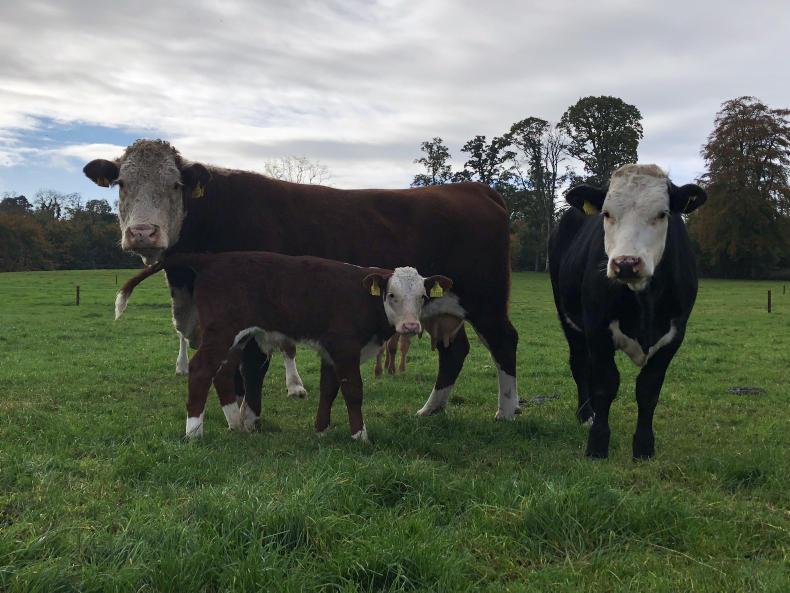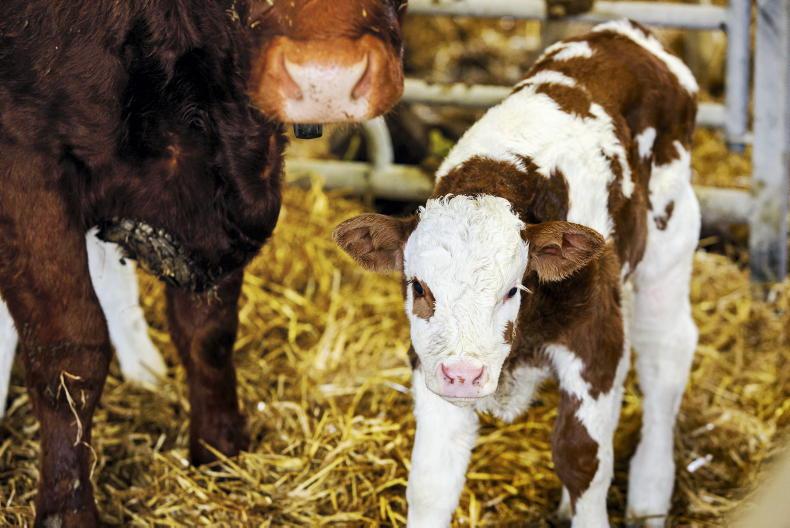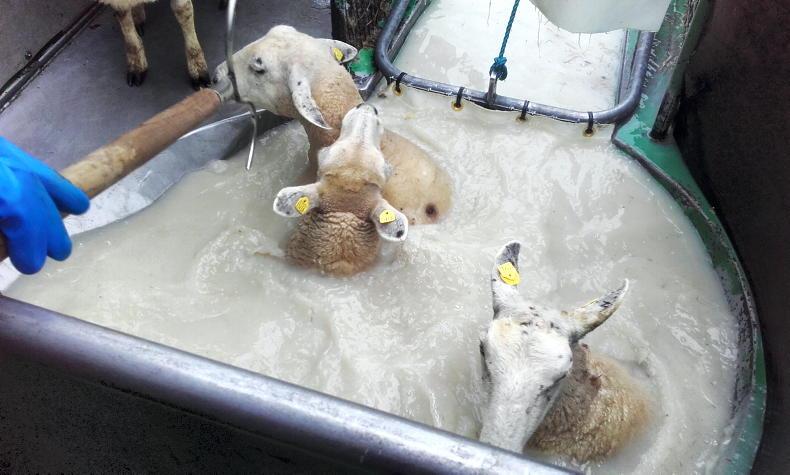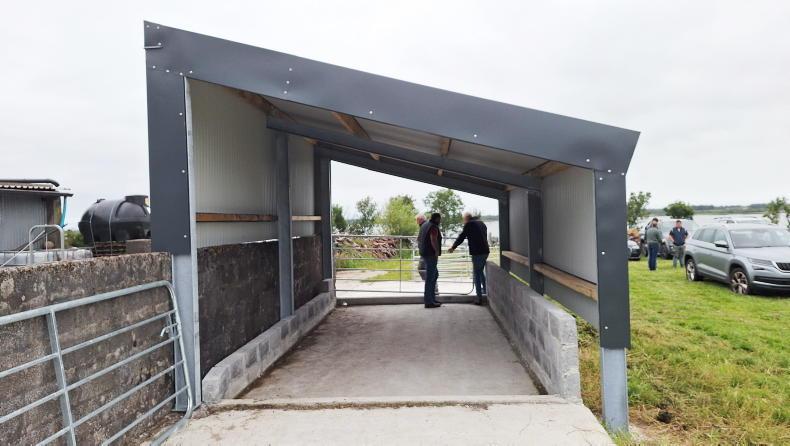Raymond, Dwayne and Gilbert Stanley run a suckler and dairy calf-to-beef operation on 123ha (304ac) in Co Tipperary.
Since joining the BETTER farm beef challenge almost two years ago, the main challenge for this farm, due to its scale, has been to implement a system which can sufficiently stock the land and subsequently increase the output per hectare.
Beginning with a herd of just over 100 suckler cows, a target of 120 was set for programme end. The land could carry more cows, but labour and housing facilities are not as readily available.
Instead, the decision was taken to introduce a large-scale dairy calf-to-beef operation. The plan is to buy 120 dairy calves each year – 60 in the spring and 60 in the autumn – to run alongside the farm’s own suckler bred stock.
All stock on the farm are taken to finish as steers and heifers, apart some heifers that are kept as replacements.

Dyayne (left) and Gilbert (right) Stanley with BETTER Farm adviser Alan Dillon from Teagasc.
Autumn calving
Limited calving facilities mean the farm is 50:50 spring and autumn calving.
Dwayne says: “I really like the autumn calving. It seems to be working very well for us here, with calf health and management much better than in the spring. I’d definitely consider calving a higher proportion of the herd in autumn in future.”
The major successes of the autumn herd over the last year has come from better breeding management. The plan is to limit the calving period to just two months. A tight calving period is critical on suckler farms, but especially in split calving systems. This autumn, the farm has seen a dramatic improvement with 48 out of 51calving inside seven weeks.
From those 48 cows, there are 50 calves on the ground. One set of twins died at birth, so a calf was purchased for that cow to foster.
Vaccines
The tight calving spread makes calf management much easier says Dwayne, with calves dehorned and vaccinated in larger batches. “We vaccinate all calves for RSV and Pi3, for clostridial disease and for coccidiosis,” he said.
Another key change has been the introduction of AI. This has given the Stanleys a much greater choice of genetics to incorporate into their herd. Breeding in the autumn herd takes place indoors and Dwayne says: “I’ll have the Simmental bull working with one group of cows, the Limousin will be with another and the final group of cows will be culls and cows for AI. I check the cows for AI five or six times each day.”
Now that calving is almost complete, the focus is turning to breeding: “All cows are receiving their lepto [leptospirosis] vaccinations at the minute and the replacement heifers will get their booster shot. We don’t vaccinate for BVD anymore. Cows are also vaccinated for IBR as recent blood samples showed an underlying IBR presence.”
To learn more about the Stanleys' calf-to-beef operation, see this week’s Irish Farmers Journal.
Raymond, Dwayne and Gilbert Stanley run a suckler and dairy calf-to-beef operation on 123ha (304ac) in Co Tipperary.
Since joining the BETTER farm beef challenge almost two years ago, the main challenge for this farm, due to its scale, has been to implement a system which can sufficiently stock the land and subsequently increase the output per hectare.
Beginning with a herd of just over 100 suckler cows, a target of 120 was set for programme end. The land could carry more cows, but labour and housing facilities are not as readily available.
Instead, the decision was taken to introduce a large-scale dairy calf-to-beef operation. The plan is to buy 120 dairy calves each year – 60 in the spring and 60 in the autumn – to run alongside the farm’s own suckler bred stock.
All stock on the farm are taken to finish as steers and heifers, apart some heifers that are kept as replacements.

Dyayne (left) and Gilbert (right) Stanley with BETTER Farm adviser Alan Dillon from Teagasc.
Autumn calving
Limited calving facilities mean the farm is 50:50 spring and autumn calving.
Dwayne says: “I really like the autumn calving. It seems to be working very well for us here, with calf health and management much better than in the spring. I’d definitely consider calving a higher proportion of the herd in autumn in future.”
The major successes of the autumn herd over the last year has come from better breeding management. The plan is to limit the calving period to just two months. A tight calving period is critical on suckler farms, but especially in split calving systems. This autumn, the farm has seen a dramatic improvement with 48 out of 51calving inside seven weeks.
From those 48 cows, there are 50 calves on the ground. One set of twins died at birth, so a calf was purchased for that cow to foster.
Vaccines
The tight calving spread makes calf management much easier says Dwayne, with calves dehorned and vaccinated in larger batches. “We vaccinate all calves for RSV and Pi3, for clostridial disease and for coccidiosis,” he said.
Another key change has been the introduction of AI. This has given the Stanleys a much greater choice of genetics to incorporate into their herd. Breeding in the autumn herd takes place indoors and Dwayne says: “I’ll have the Simmental bull working with one group of cows, the Limousin will be with another and the final group of cows will be culls and cows for AI. I check the cows for AI five or six times each day.”
Now that calving is almost complete, the focus is turning to breeding: “All cows are receiving their lepto [leptospirosis] vaccinations at the minute and the replacement heifers will get their booster shot. We don’t vaccinate for BVD anymore. Cows are also vaccinated for IBR as recent blood samples showed an underlying IBR presence.”
To learn more about the Stanleys' calf-to-beef operation, see this week’s Irish Farmers Journal.










SHARING OPTIONS